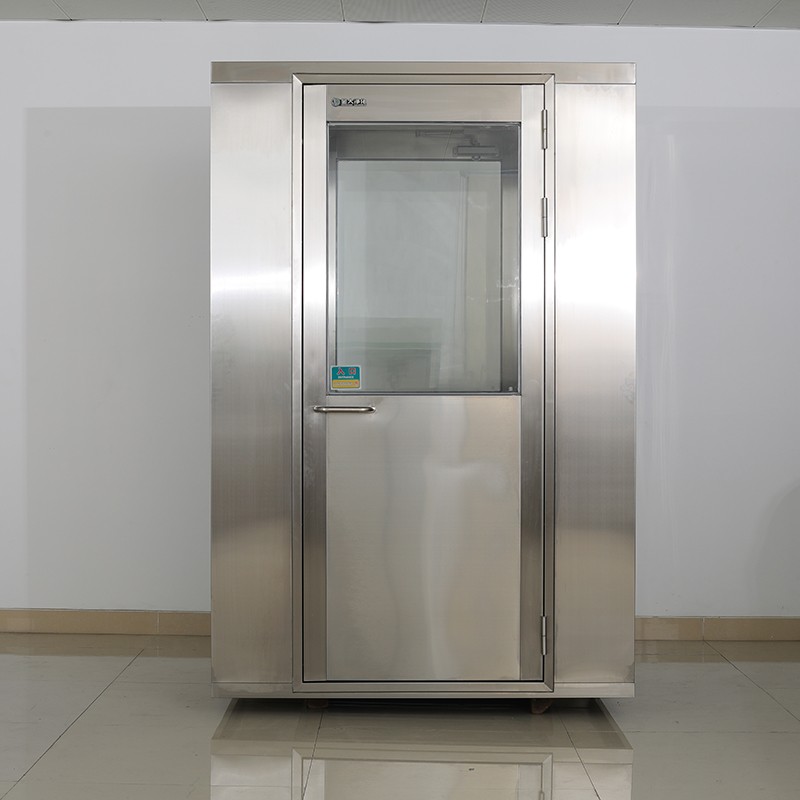Key Features and Components of an Air Shower
2024-06-05
An air shower is a specialized enclosed chamber designed to reduce particle contamination when moving between different areas of a facility, particularly in environments that require strict cleanliness standards, such as cleanrooms, laboratories, and manufacturing plants. The primary function of an air shower is to blow high-velocity air onto personnel or equipment to dislodge and remove loose particles from their surfaces before they enter a clean zone.
Key Features and Components of an Air Shower
1. Enclosure:
- Construction: Typically made from stainless steel or powder-coated steel to ensure durability and cleanliness.
- Doors: Equipped with interlocking doors that prevent both doors from being open simultaneously, ensuring that one side is always sealed during operation.
2. High-Velocity Air Jets:
- Nozzles: Strategically placed nozzles on walls and ceilings direct high-velocity air at personnel or equipment.
- Velocity: Air jets typically operate at speeds of 20-30 meters per second to effectively remove particles.
3. HEPA/ULPA Filters:
- Filtration: High-Efficiency Particulate Air (HEPA) or Ultra-Low Penetration Air (ULPA) filters clean the air before it is blown through the nozzles, ensuring that only clean air contacts the personnel or equipment.
4. Blowers:
- Air Supply: High-capacity blowers supply the necessary airflow for the air jets, ensuring consistent and effective particle removal.
5. Control System:
- Operation: Automated controls manage the air shower cycle, including the duration of the air shower and the interlocking mechanism of the doors.
- Sensors: Motion sensors or manual activation buttons initiate the air shower cycle when personnel or equipment enter.
6. Lighting:
- Illumination: Bright, cleanroom-compatible lighting ensures visibility within the air shower chamber.
Operation of an Air Shower
1. Entry: Personnel or equipment enter the air shower chamber through the entry door.
2. Activation: The air shower cycle is activated either automatically via sensors or manually via a control button.
3. Air Shower Cycle: High-velocity air jets blow over the surfaces of personnel or equipment, dislodging and removing loose particles. The air is then recirculated through HEPA/ULPA filters to capture and remove the dislodged particles.
4. Exit: Once the air shower cycle is complete, the exit door unlocks, allowing personnel or equipment to enter the cleanroom or controlled environment.
Applications of Air Showers
- Cleanrooms: Used in semiconductor manufacturing, pharmaceutical production, biotechnology labs, and other environments requiring minimal particle contamination.
- Laboratories: Ensures that contaminants do not enter sensitive experimental areas.
- Food Processing: Maintains hygiene and prevents contamination in food production areas.
- Healthcare: Used in hospitals and clinics to maintain sterile conditions in surgical suites and isolation rooms.
Benefits of Using Air Showers
- Particle Reduction: Significantly reduces the number of particles carried by personnel or equipment, maintaining cleanroom standards.
- Contamination Control: Prevents contaminants from entering controlled environments, ensuring product quality and safety.
- Compliance: Helps facilities meet industry standards and regulations for cleanliness and contamination control.
- Efficiency: Automated operation and high-efficiency filtration make air showers an effective and reliable solution for maintaining clean environments.
Maintenance and Best Practices
- Regular Filter Replacement: HEPA/ULPA filters should be checked and replaced periodically to ensure effective filtration.
- Routine Cleaning: The interior surfaces of the air shower should be cleaned regularly to prevent buildup of contaminants.
- System Inspection: Regular inspection of blowers, nozzles, and control systems to ensure optimal performance.
- Training: Personnel should be trained on the proper use and operation of the air shower to maximize its effectiveness.
Common Challenges and Solutions
- Airflow Obstructions: Ensure that nozzles are unobstructed and properly aligned for optimal air jet coverage.
- Filter Clogging: Regularly monitor and replace filters to prevent reduced airflow and filtration efficiency.
- System Downtime: Implement a maintenance schedule to minimize downtime and ensure continuous operation.
By understanding the components, operation, and benefits of air showers, facilities can effectively reduce contamination risks and maintain high standards of cleanliness in critical environments.



